Nike Brand Extension Report: Target Market and Competitors
VerifiedAdded on 2022/12/30
|7
|1534
|462
Report
AI Summary
This report provides a comprehensive analysis of Nike's brand extension strategy, focusing on the introduction of the new "Nike Repellent" product. The report begins with an executive summary and introduction to brand extension, followed by a detailed methodology section. Key findings include an examination of Nike's existing brand value, utilizing Kapferer's Brand Identity Prism to assess its personality, relationships, culture, and physique. The report then delves into target market analysis, employing STP (Segmentation, Targeting, Positioning) to identify key consumer segments. Furthermore, it applies Ansoff's matrix and PESTLE analysis to evaluate the new market opportunities and potential challenges. A comparative analysis of competitors such as Adidas and Puma is also included, highlighting the innovative features of Nike Repellent. The report concludes by summarizing the key insights and implications of Nike's brand extension efforts.

Brand extension report
Paraphrase This Document
Need a fresh take? Get an instant paraphrase of this document with our AI Paraphraser
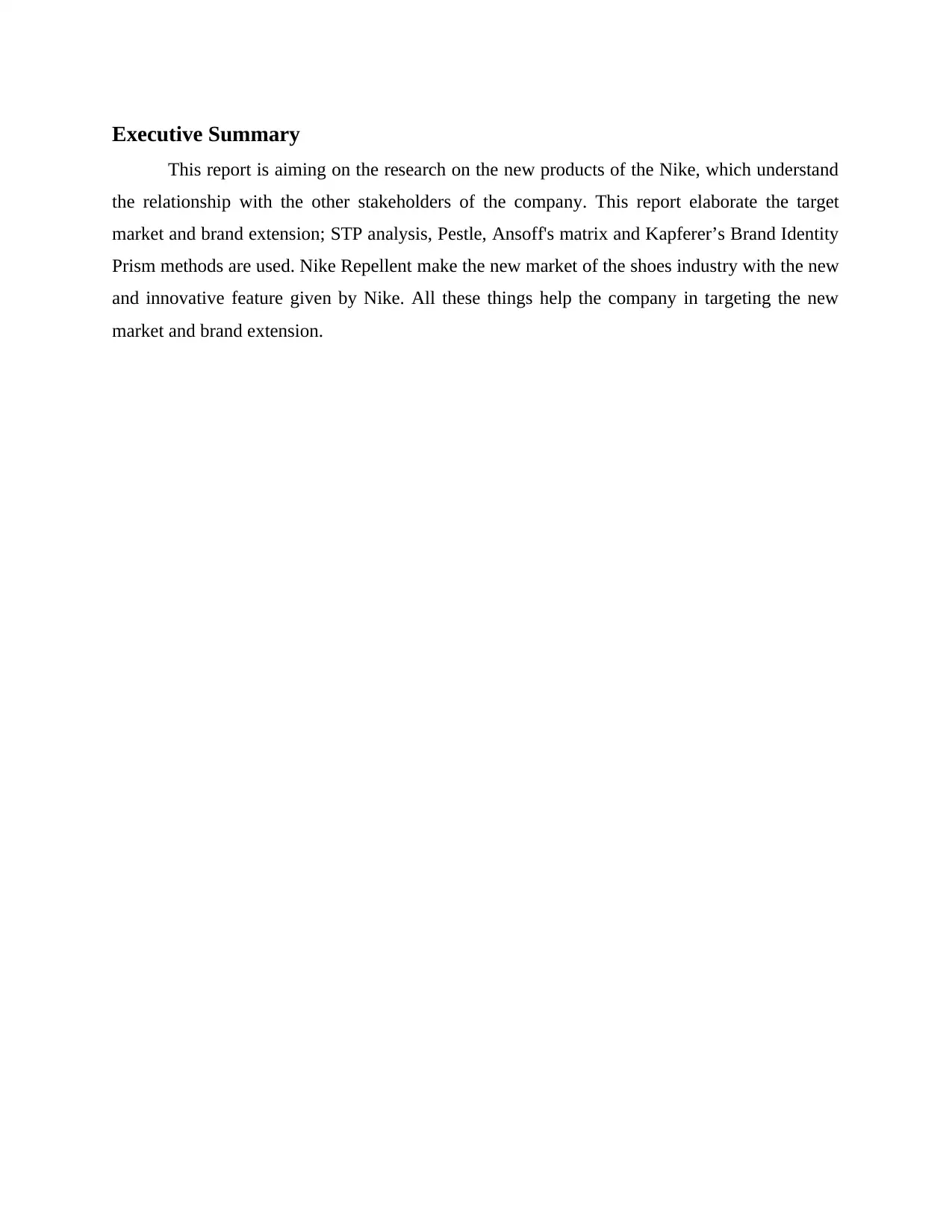
Executive Summary
This report is aiming on the research on the new products of the Nike, which understand
the relationship with the other stakeholders of the company. This report elaborate the target
market and brand extension; STP analysis, Pestle, Ansoff's matrix and Kapferer’s Brand Identity
Prism methods are used. Nike Repellent make the new market of the shoes industry with the new
and innovative feature given by Nike. All these things help the company in targeting the new
market and brand extension.
This report is aiming on the research on the new products of the Nike, which understand
the relationship with the other stakeholders of the company. This report elaborate the target
market and brand extension; STP analysis, Pestle, Ansoff's matrix and Kapferer’s Brand Identity
Prism methods are used. Nike Repellent make the new market of the shoes industry with the new
and innovative feature given by Nike. All these things help the company in targeting the new
market and brand extension.
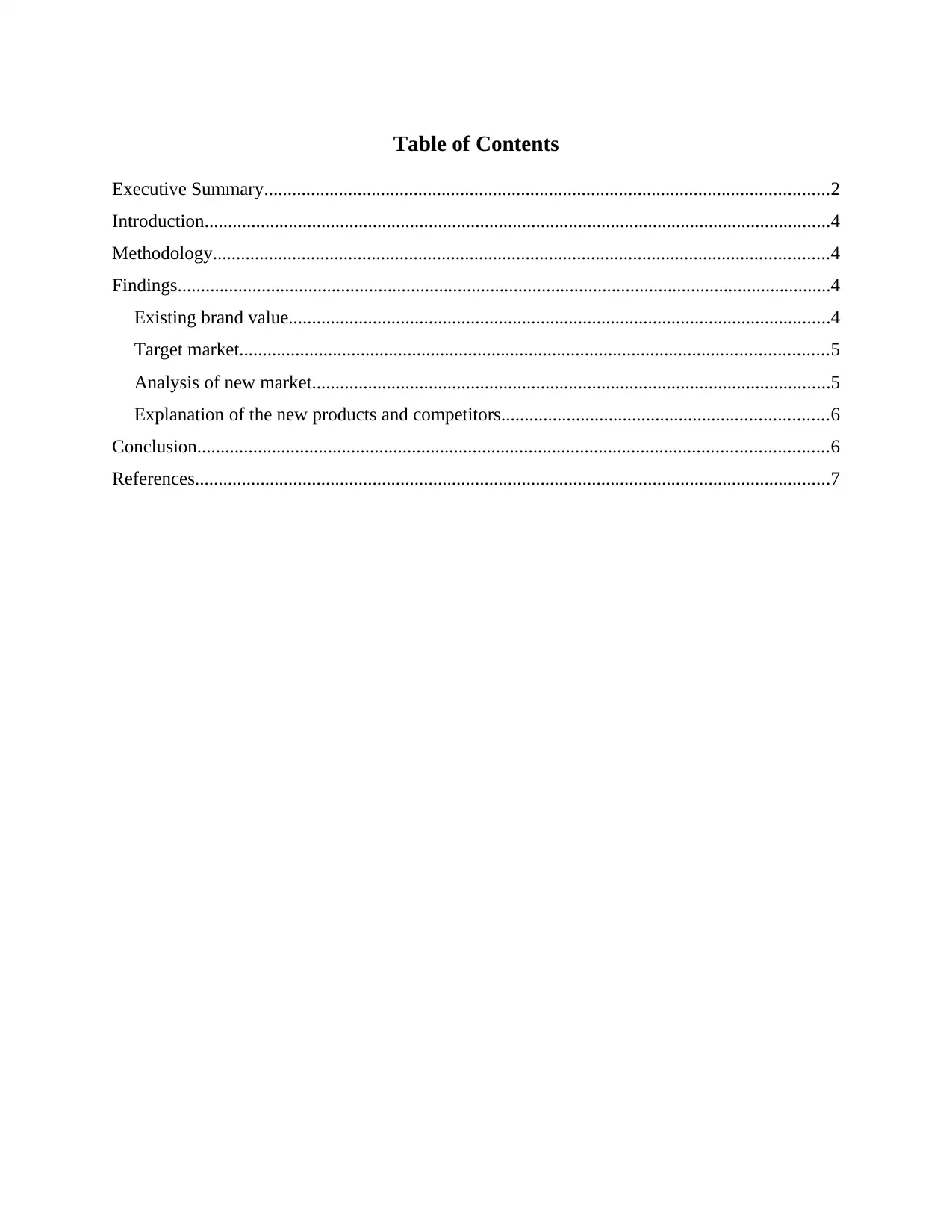
Table of Contents
Executive Summary.........................................................................................................................2
Introduction......................................................................................................................................4
Methodology....................................................................................................................................4
Findings............................................................................................................................................4
Existing brand value....................................................................................................................4
Target market..............................................................................................................................5
Analysis of new market...............................................................................................................5
Explanation of the new products and competitors......................................................................6
Conclusion.......................................................................................................................................6
References........................................................................................................................................7
Executive Summary.........................................................................................................................2
Introduction......................................................................................................................................4
Methodology....................................................................................................................................4
Findings............................................................................................................................................4
Existing brand value....................................................................................................................4
Target market..............................................................................................................................5
Analysis of new market...............................................................................................................5
Explanation of the new products and competitors......................................................................6
Conclusion.......................................................................................................................................6
References........................................................................................................................................7
⊘ This is a preview!⊘
Do you want full access?
Subscribe today to unlock all pages.

Trusted by 1+ million students worldwide
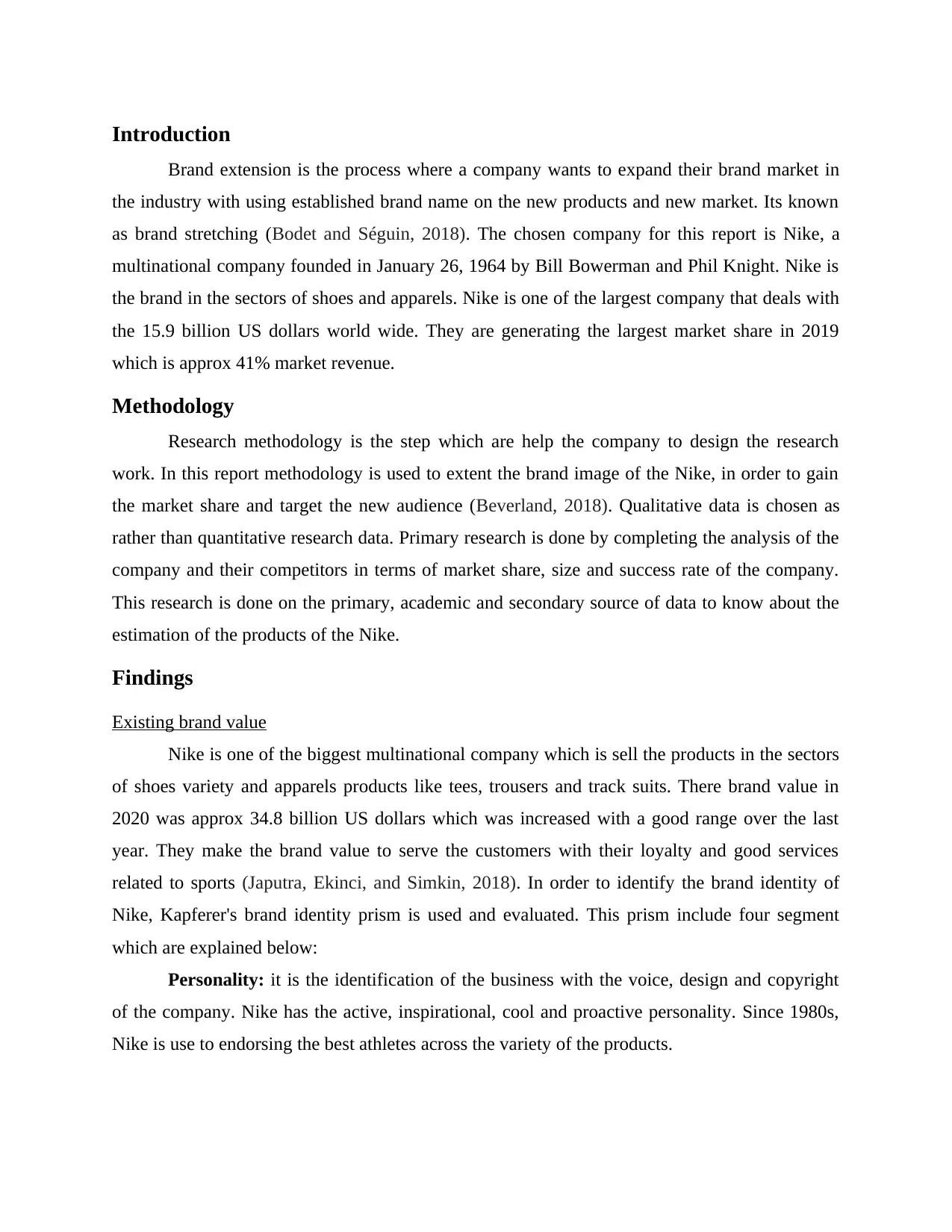
Introduction
Brand extension is the process where a company wants to expand their brand market in
the industry with using established brand name on the new products and new market. Its known
as brand stretching (Bodet and Séguin, 2018). The chosen company for this report is Nike, a
multinational company founded in January 26, 1964 by Bill Bowerman and Phil Knight. Nike is
the brand in the sectors of shoes and apparels. Nike is one of the largest company that deals with
the 15.9 billion US dollars world wide. They are generating the largest market share in 2019
which is approx 41% market revenue.
Methodology
Research methodology is the step which are help the company to design the research
work. In this report methodology is used to extent the brand image of the Nike, in order to gain
the market share and target the new audience (Beverland, 2018). Qualitative data is chosen as
rather than quantitative research data. Primary research is done by completing the analysis of the
company and their competitors in terms of market share, size and success rate of the company.
This research is done on the primary, academic and secondary source of data to know about the
estimation of the products of the Nike.
Findings
Existing brand value
Nike is one of the biggest multinational company which is sell the products in the sectors
of shoes variety and apparels products like tees, trousers and track suits. There brand value in
2020 was approx 34.8 billion US dollars which was increased with a good range over the last
year. They make the brand value to serve the customers with their loyalty and good services
related to sports (Japutra, Ekinci, and Simkin, 2018). In order to identify the brand identity of
Nike, Kapferer's brand identity prism is used and evaluated. This prism include four segment
which are explained below:
Personality: it is the identification of the business with the voice, design and copyright
of the company. Nike has the active, inspirational, cool and proactive personality. Since 1980s,
Nike is use to endorsing the best athletes across the variety of the products.
Brand extension is the process where a company wants to expand their brand market in
the industry with using established brand name on the new products and new market. Its known
as brand stretching (Bodet and Séguin, 2018). The chosen company for this report is Nike, a
multinational company founded in January 26, 1964 by Bill Bowerman and Phil Knight. Nike is
the brand in the sectors of shoes and apparels. Nike is one of the largest company that deals with
the 15.9 billion US dollars world wide. They are generating the largest market share in 2019
which is approx 41% market revenue.
Methodology
Research methodology is the step which are help the company to design the research
work. In this report methodology is used to extent the brand image of the Nike, in order to gain
the market share and target the new audience (Beverland, 2018). Qualitative data is chosen as
rather than quantitative research data. Primary research is done by completing the analysis of the
company and their competitors in terms of market share, size and success rate of the company.
This research is done on the primary, academic and secondary source of data to know about the
estimation of the products of the Nike.
Findings
Existing brand value
Nike is one of the biggest multinational company which is sell the products in the sectors
of shoes variety and apparels products like tees, trousers and track suits. There brand value in
2020 was approx 34.8 billion US dollars which was increased with a good range over the last
year. They make the brand value to serve the customers with their loyalty and good services
related to sports (Japutra, Ekinci, and Simkin, 2018). In order to identify the brand identity of
Nike, Kapferer's brand identity prism is used and evaluated. This prism include four segment
which are explained below:
Personality: it is the identification of the business with the voice, design and copyright
of the company. Nike has the active, inspirational, cool and proactive personality. Since 1980s,
Nike is use to endorsing the best athletes across the variety of the products.
Paraphrase This Document
Need a fresh take? Get an instant paraphrase of this document with our AI Paraphraser
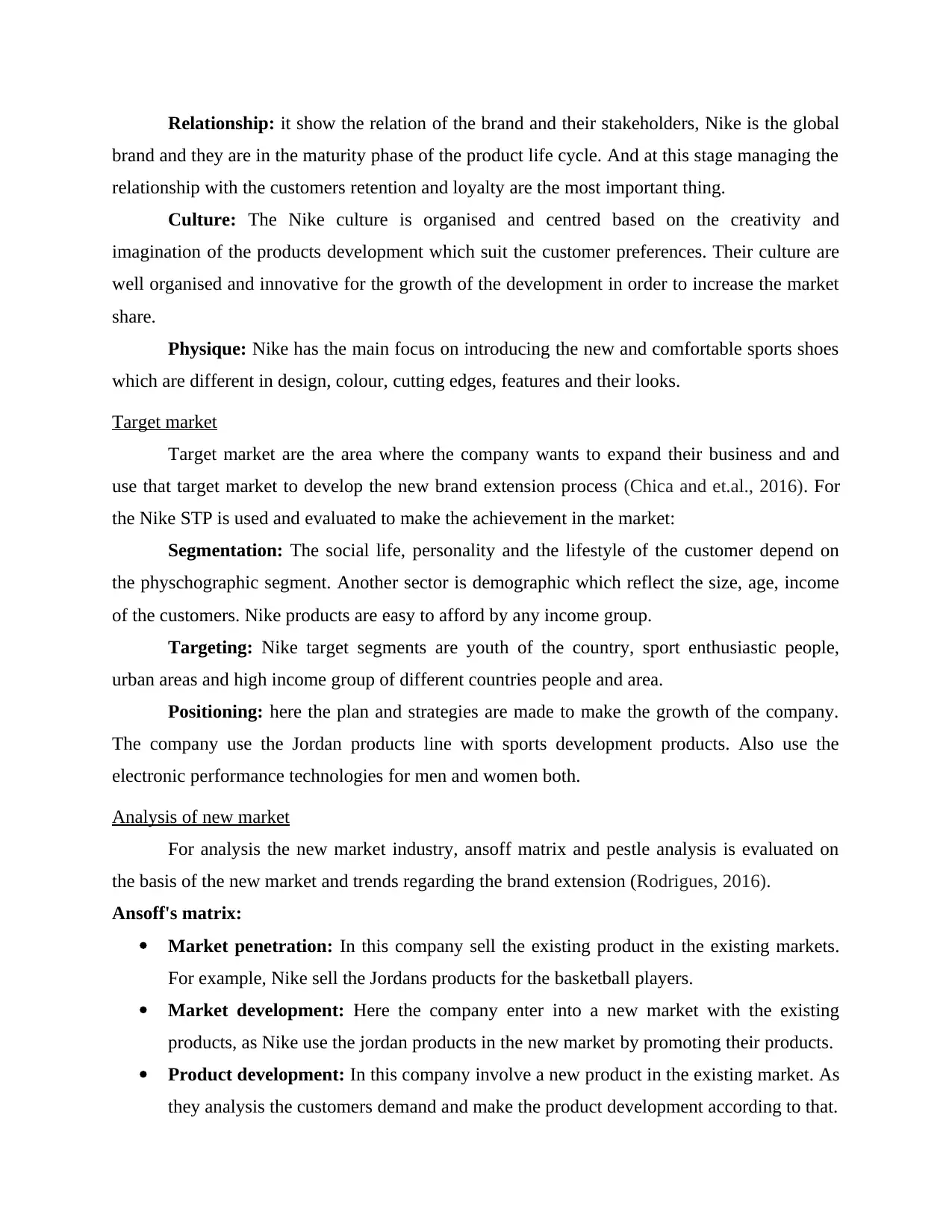
Relationship: it show the relation of the brand and their stakeholders, Nike is the global
brand and they are in the maturity phase of the product life cycle. And at this stage managing the
relationship with the customers retention and loyalty are the most important thing.
Culture: The Nike culture is organised and centred based on the creativity and
imagination of the products development which suit the customer preferences. Their culture are
well organised and innovative for the growth of the development in order to increase the market
share.
Physique: Nike has the main focus on introducing the new and comfortable sports shoes
which are different in design, colour, cutting edges, features and their looks.
Target market
Target market are the area where the company wants to expand their business and and
use that target market to develop the new brand extension process (Chica and et.al., 2016). For
the Nike STP is used and evaluated to make the achievement in the market:
Segmentation: The social life, personality and the lifestyle of the customer depend on
the physchographic segment. Another sector is demographic which reflect the size, age, income
of the customers. Nike products are easy to afford by any income group.
Targeting: Nike target segments are youth of the country, sport enthusiastic people,
urban areas and high income group of different countries people and area.
Positioning: here the plan and strategies are made to make the growth of the company.
The company use the Jordan products line with sports development products. Also use the
electronic performance technologies for men and women both.
Analysis of new market
For analysis the new market industry, ansoff matrix and pestle analysis is evaluated on
the basis of the new market and trends regarding the brand extension (Rodrigues, 2016).
Ansoff's matrix:
Market penetration: In this company sell the existing product in the existing markets.
For example, Nike sell the Jordans products for the basketball players.
Market development: Here the company enter into a new market with the existing
products, as Nike use the jordan products in the new market by promoting their products.
Product development: In this company involve a new product in the existing market. As
they analysis the customers demand and make the product development according to that.
brand and they are in the maturity phase of the product life cycle. And at this stage managing the
relationship with the customers retention and loyalty are the most important thing.
Culture: The Nike culture is organised and centred based on the creativity and
imagination of the products development which suit the customer preferences. Their culture are
well organised and innovative for the growth of the development in order to increase the market
share.
Physique: Nike has the main focus on introducing the new and comfortable sports shoes
which are different in design, colour, cutting edges, features and their looks.
Target market
Target market are the area where the company wants to expand their business and and
use that target market to develop the new brand extension process (Chica and et.al., 2016). For
the Nike STP is used and evaluated to make the achievement in the market:
Segmentation: The social life, personality and the lifestyle of the customer depend on
the physchographic segment. Another sector is demographic which reflect the size, age, income
of the customers. Nike products are easy to afford by any income group.
Targeting: Nike target segments are youth of the country, sport enthusiastic people,
urban areas and high income group of different countries people and area.
Positioning: here the plan and strategies are made to make the growth of the company.
The company use the Jordan products line with sports development products. Also use the
electronic performance technologies for men and women both.
Analysis of new market
For analysis the new market industry, ansoff matrix and pestle analysis is evaluated on
the basis of the new market and trends regarding the brand extension (Rodrigues, 2016).
Ansoff's matrix:
Market penetration: In this company sell the existing product in the existing markets.
For example, Nike sell the Jordans products for the basketball players.
Market development: Here the company enter into a new market with the existing
products, as Nike use the jordan products in the new market by promoting their products.
Product development: In this company involve a new product in the existing market. As
they analysis the customers demand and make the product development according to that.
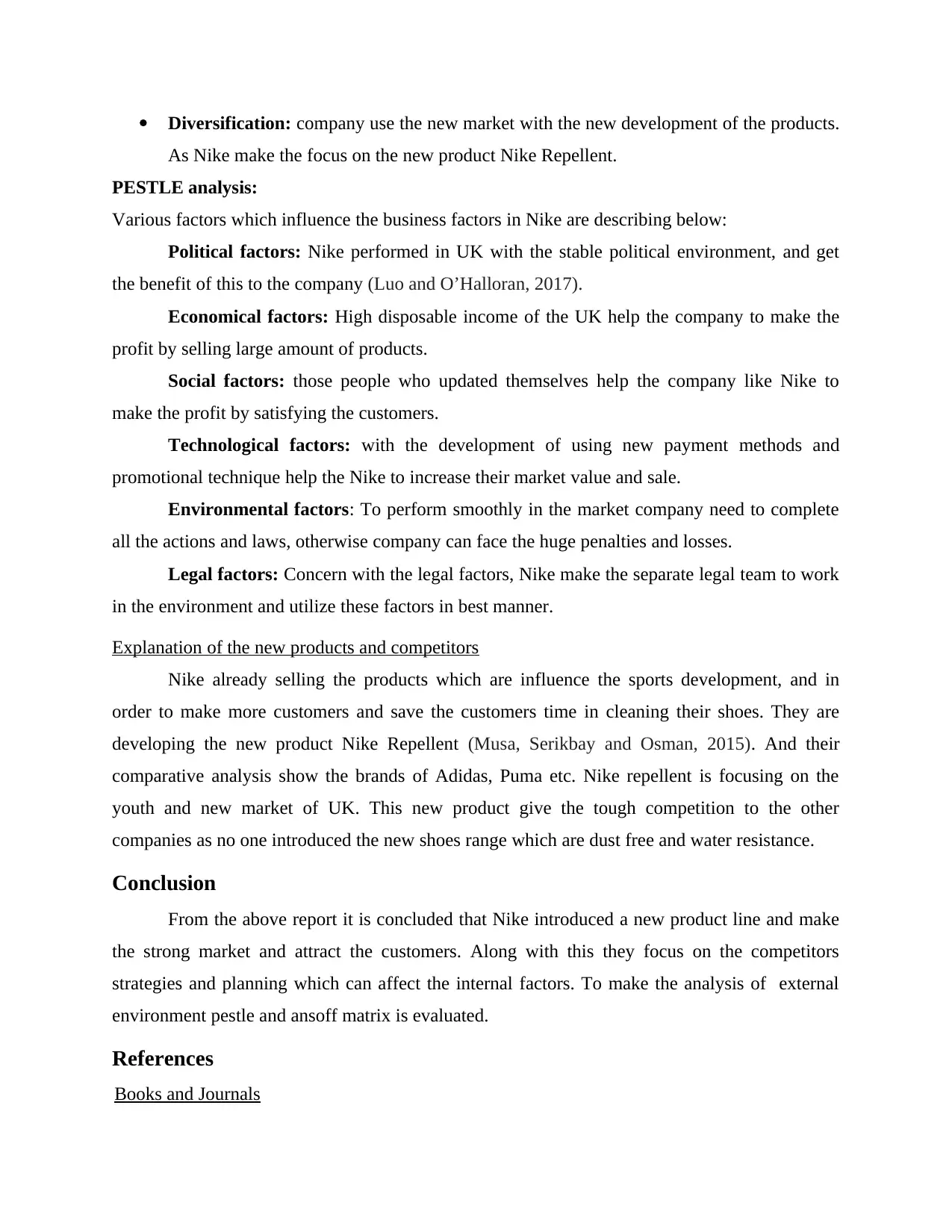
Diversification: company use the new market with the new development of the products.
As Nike make the focus on the new product Nike Repellent.
PESTLE analysis:
Various factors which influence the business factors in Nike are describing below:
Political factors: Nike performed in UK with the stable political environment, and get
the benefit of this to the company (Luo and O’Halloran, 2017).
Economical factors: High disposable income of the UK help the company to make the
profit by selling large amount of products.
Social factors: those people who updated themselves help the company like Nike to
make the profit by satisfying the customers.
Technological factors: with the development of using new payment methods and
promotional technique help the Nike to increase their market value and sale.
Environmental factors: To perform smoothly in the market company need to complete
all the actions and laws, otherwise company can face the huge penalties and losses.
Legal factors: Concern with the legal factors, Nike make the separate legal team to work
in the environment and utilize these factors in best manner.
Explanation of the new products and competitors
Nike already selling the products which are influence the sports development, and in
order to make more customers and save the customers time in cleaning their shoes. They are
developing the new product Nike Repellent (Musa, Serikbay and Osman, 2015). And their
comparative analysis show the brands of Adidas, Puma etc. Nike repellent is focusing on the
youth and new market of UK. This new product give the tough competition to the other
companies as no one introduced the new shoes range which are dust free and water resistance.
Conclusion
From the above report it is concluded that Nike introduced a new product line and make
the strong market and attract the customers. Along with this they focus on the competitors
strategies and planning which can affect the internal factors. To make the analysis of external
environment pestle and ansoff matrix is evaluated.
References
Books and Journals
As Nike make the focus on the new product Nike Repellent.
PESTLE analysis:
Various factors which influence the business factors in Nike are describing below:
Political factors: Nike performed in UK with the stable political environment, and get
the benefit of this to the company (Luo and O’Halloran, 2017).
Economical factors: High disposable income of the UK help the company to make the
profit by selling large amount of products.
Social factors: those people who updated themselves help the company like Nike to
make the profit by satisfying the customers.
Technological factors: with the development of using new payment methods and
promotional technique help the Nike to increase their market value and sale.
Environmental factors: To perform smoothly in the market company need to complete
all the actions and laws, otherwise company can face the huge penalties and losses.
Legal factors: Concern with the legal factors, Nike make the separate legal team to work
in the environment and utilize these factors in best manner.
Explanation of the new products and competitors
Nike already selling the products which are influence the sports development, and in
order to make more customers and save the customers time in cleaning their shoes. They are
developing the new product Nike Repellent (Musa, Serikbay and Osman, 2015). And their
comparative analysis show the brands of Adidas, Puma etc. Nike repellent is focusing on the
youth and new market of UK. This new product give the tough competition to the other
companies as no one introduced the new shoes range which are dust free and water resistance.
Conclusion
From the above report it is concluded that Nike introduced a new product line and make
the strong market and attract the customers. Along with this they focus on the competitors
strategies and planning which can affect the internal factors. To make the analysis of external
environment pestle and ansoff matrix is evaluated.
References
Books and Journals
⊘ This is a preview!⊘
Do you want full access?
Subscribe today to unlock all pages.

Trusted by 1+ million students worldwide

Beverland, M., 2018. Brand management: Co-creating meaningful brands. Sage.
Bodet, G. and Séguin, B., 2018. Team Sports Brand Management. In Managing Sports Teams
(pp. 141-159). Springer, Cham.
Chica, M. and et.al., 2016. Identimod: Modeling and managing brand value using soft
computing. Decision Support Systems. 89. pp.41-55.
Japutra, A., Ekinci, Y. and Simkin, L., 2018. Positive and negative behaviours resulting from
brand attachment. European Journal of Marketing.
Luo, D. and O’Halloran, R., 2017. A comparative study of hotel brand building in the USA and
China. International CHRIE.
Musa, C., Serikbay, S. Y. and Osman, D., 2015. Brand management and brand identity
perspectives in business enterprises. Вестник университета Туран. (2). pp.80-85.
Rodrigues, P. C. L., 2016. Brand identity it’s important in consumer behavior of caracol brand?.
International Journal of Engineering and Industrial Management. (6). pp.23-33.
Bodet, G. and Séguin, B., 2018. Team Sports Brand Management. In Managing Sports Teams
(pp. 141-159). Springer, Cham.
Chica, M. and et.al., 2016. Identimod: Modeling and managing brand value using soft
computing. Decision Support Systems. 89. pp.41-55.
Japutra, A., Ekinci, Y. and Simkin, L., 2018. Positive and negative behaviours resulting from
brand attachment. European Journal of Marketing.
Luo, D. and O’Halloran, R., 2017. A comparative study of hotel brand building in the USA and
China. International CHRIE.
Musa, C., Serikbay, S. Y. and Osman, D., 2015. Brand management and brand identity
perspectives in business enterprises. Вестник университета Туран. (2). pp.80-85.
Rodrigues, P. C. L., 2016. Brand identity it’s important in consumer behavior of caracol brand?.
International Journal of Engineering and Industrial Management. (6). pp.23-33.
1 out of 7
Related Documents
Your All-in-One AI-Powered Toolkit for Academic Success.
+13062052269
info@desklib.com
Available 24*7 on WhatsApp / Email
![[object Object]](/_next/static/media/star-bottom.7253800d.svg)
Unlock your academic potential
Copyright © 2020–2025 A2Z Services. All Rights Reserved. Developed and managed by ZUCOL.





